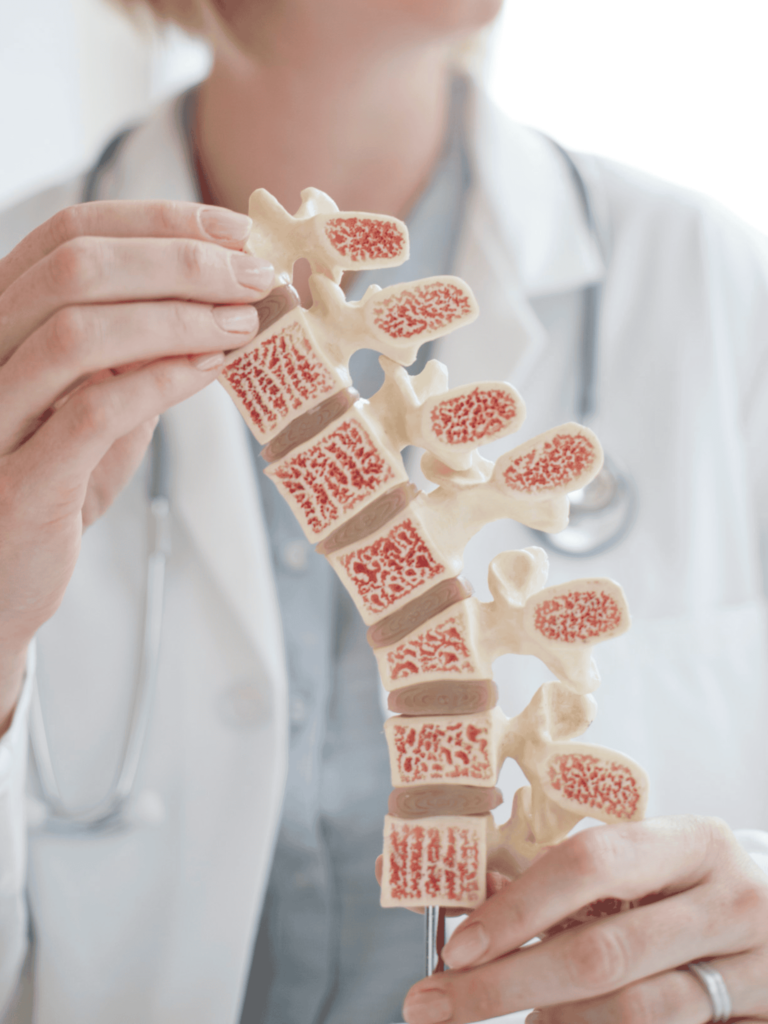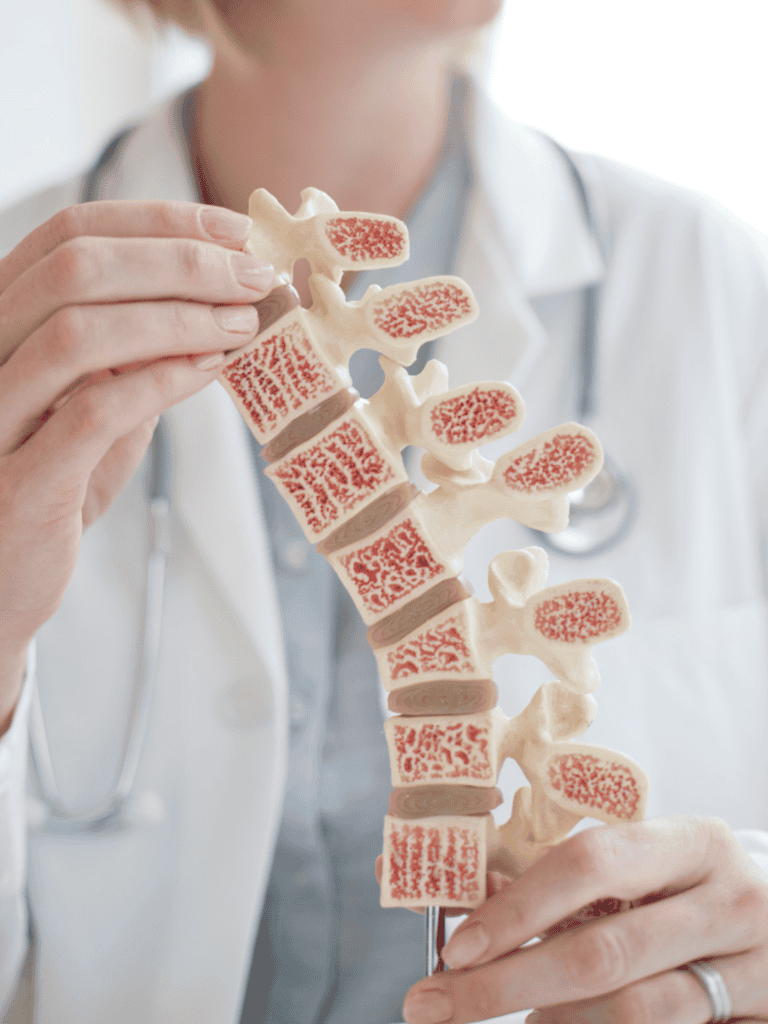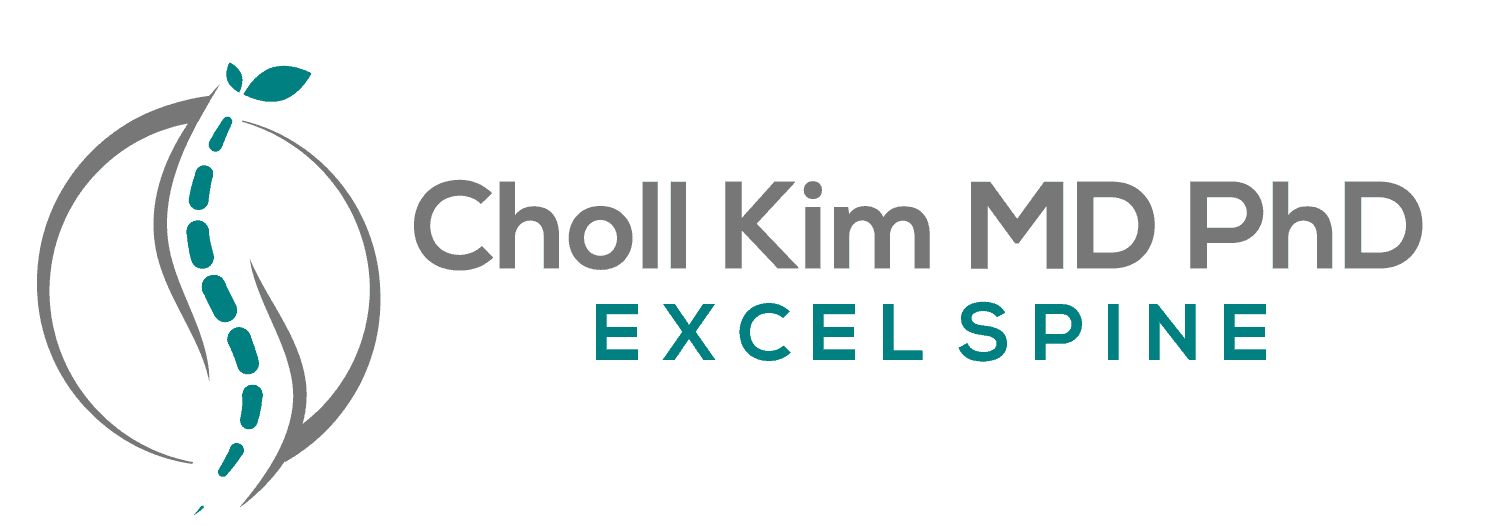
Osteoporosis is a common condition that weakens bones, making them fragile and more likely to break. For patients with osteoporosis, maintaining spine health is crucial due to the spine’s central role in supporting the body. Minimally Invasive Spine Surgery (MIS) offers significant benefits for patients with osteoporosis that need spine surgery, combining effectiveness with reduced recovery times and less postoperative pain. This article explores how MIS, including the use of fenestrated screws with cement augmentation, can help preserve bone health in osteoporosis patients.

Understanding Osteoporosis
Osteoporosis is a condition where decreased bone density and quality make bones more fragile and prone to fractures. Predominantly affecting older adults, especially postmenopausal women, osteoporosis also impacts men and younger individuals with risk factors like inadequate calcium or vitamin D intake, sedentary lifestyles, smoking, and excessive alcohol consumption.
Osteoporosis develops when the creation of new bone doesn’t keep up with the removal of old bone. Aging, hormonal changes, nutritional deficiencies, and lifestyle factors all contribute to this imbalance. Osteoporosis is often called a “silent disease” because it progresses without noticeable symptoms until a fracture occurs. Common symptoms include fractures, loss of height, back pain, and postural changes like kyphosis.
Diagnosis involves assessing bone density through a DEXA scan, measuring the mineral content in bones. Other diagnostic tools include bone turnover markers and the FRAX tool, which estimates the 10-year probability of fractures based on risk factors and bone density.
The spine is particularly vulnerable to osteoporosis, as it bears much of the body’s weight and is essential for movement and posture. Osteoporosis-related fractures most commonly affect the vertebrae, leading to vertebral compression fractures (VCFs),
sudden back pain, and kyphosis. Persistent pain from vertebral fractures can significantly impact quality of life, limiting mobility and daily activities. The physical limitations imposed by osteoporosis-related spinal issues can lead to a decreased ability to perform daily tasks, increasing dependence on others. Reduced mobility can also lead to muscle atrophy, further weakening the skeletal structure and increasing the risk of additional fractures.
Early detection of osteoporosis is crucial for preventing severe complications. Regular bone density screenings, especially for individuals at high risk, can identify osteoporosis before significant bone loss occurs. Preventative measures include ensuring adequate intake of calcium and vitamin D, incorporating weight-bearing and resistance exercises, and using medications like bisphosphonates to help slow bone loss and increase bone density.
Understanding osteoporosis and its impact on the spine highlights the importance of advanced treatments. This is where Minimally Invasive Spine Surgery (MIS) comes into play, offering effective solutions to stabilize the spine and improve quality of life for those affected by osteoporosis.
The Role of Minimally Invasive Spine Surgery (MIS)
MIS is a modern approach to spine surgery that uses small incisions, specialized instruments, and advanced imaging techniques to treat spinal conditions. Unlike traditional open surgery, MIS minimizes tissue damage, reduces blood loss, and promotes quicker recovery. This approach is particularly beneficial for osteoporosis patients due to the following advantages.
MIS involves smaller incisions, which result in less trauma to muscles and soft tissues around the spine. This reduces postoperative pain and the risk of complications such as infections. Patients typically experience shorter hospital stays and faster recovery times, enabling them to return to their normal activities more quickly.
For osteoporosis patients, MIS offers several specific benefits. The reduced trauma to surrounding tissues is crucial since their bones are already fragile and prone to fractures. MIS techniques help to stabilize the spine without causing additional harm to the delicate bone structures. This approach also lowers the risk of postoperative complications, which is particularly important for elderly patients or those with comorbid conditions.
Fenestrated Screws with Cement Augmentation
Click here for a short video on how I use fenestrated screws with cement.
One of the most innovative techniques in MIS for osteoporosis patients involves the use of fenestrated screws with cement augmentation. Fenestrated screws are specialized screws with holes (fenestrations) that allow for the injection of bone cement. Dr. Kim uses this method, particularly during Transforaminal Lumbar Interbody Fusion (TLIF) procedures. By injecting polymethylmethacrylate (PMMA) cement into fenestrated pedicle screws, the screws become extremely secure, compensating for the patient’s poor bone density.
This technique does not treat osteoporosis directly but significantly enhances the effectiveness of fusion surgeries. The cement augmentation provides additional support and stabilization to the screws, reducing the risk of loosening or failure, which is crucial for patients with weak bones.
Benefits of using fenestrated screws with cement augmentation in osteoporosis patients include:
- Enhanced stability and strength of the affected vertebrae.
- Reduced risk of screw loosening or failure.
- Immediate pain relief and improved mobility.
- Lower complication rates compared to traditional methods.

Procedure for Using Fenestrated Screws
The procedure for using fenestrated screws with cement augmentation involves several key steps:
Preoperative Preparation– Before the surgery, patients undergo thorough evaluations, including imaging studies such as X-rays, CT scans, or MRIs, to determine the extent of bone damage and plan the procedure. Preoperative assessments also include evaluating the patient’s overall health and any comorbid conditions.
Surgical Procedure– During the procedure, the surgeon makes small incisions to access the spine. Using fluoroscopic guidance (real-time X-ray), fenestrated screws are carefully placed into the affected vertebrae. Once the screws are in place, bone cement is injected through the screws’ fenestrations to reinforce the bone.
Postoperative Care and Recovery– Postoperative care focuses on managing pain, preventing infection, and monitoring the stability of the spine. Patients are encouraged to start gentle movements soon after the surgery to promote healing and prevent complications. Physical therapy is often recommended to strengthen the muscles supporting the spine and improve overall function.
Other Minimally Invasive Techniques for Osteoporosis
In addition to fenestrated screws, other MIS techniques can benefit osteoporosis patients:
Endoscopic Spine Surgery: Endoscopic spine surgery uses a small camera and instruments inserted through tiny incisions to treat spine conditions. This technique minimizes tissue damage and speeds up recovery, making it ideal for patients with osteoporosis.
Microdiscectomy: Microdiscectomy involves the removal of herniated disc material that is compressing a nerve root. Using small incisions and specialized instruments, this procedure relieves pain and restores function with minimal disruption to the surrounding tissues.
Kyphoplasty: Kyphoplasty is a minimally invasive procedure specifically designed to treat vertebral compression fractures (VCFs) caused by osteoporosis. During kyphoplasty, a small balloon is inserted into the collapsed vertebra and inflated to restore height. The cavity created by the balloon is then filled with bone cement, stabilizing the fracture and reducing pain. Kyphoplasty not only provides immediate pain relief but also helps correct spinal deformities and improve overall spinal stability.
Preventative Measures for Osteoporosis Patients
Preventing osteoporosis-related complications involves a combination of early diagnosis, lifestyle changes, and medical treatments:
Early Diagnosis and Treatment: Regular bone density screenings, especially for individuals at high risk, can detect osteoporosis early and allow for timely intervention.
Lifestyle Changes and Dietary Recommendations: A balanced diet rich in calcium and vitamin D is crucial for bone health. Weight-bearing exercises, such as walking and strength training, can also help maintain bone density.
Medications and Supplements: Medications like bisphosphonates, hormone replacement therapy, and supplements such as calcium and vitamin D can help strengthen bones and reduce fracture risk.
Rehabilitation and Long-term Care
Rehabilitation and long-term care play vital roles in the overall treatment plan for osteoporosis patients:
Physical Therapy and Exercise Programs: Physical therapy focuses on exercises that strengthen the muscles supporting the spine, improve balance, and enhance mobility.
Regular Follow-ups and Monitoring: Continuous monitoring of bone density and overall health ensures that any changes in the patient’s condition are promptly addressed.
Managing Complications and Preventing Fractures: Preventing falls and managing complications through regular check-ups and adherence to treatment plans are crucial in minimizing the risk of fractures.
Conclusion
Minimally Invasive Spine Surgery (MIS) offers a promising solution for osteoporosis patients, providing effective treatment with fewer risks and faster recovery times. Techniques such as fenestrated screws with cement augmentation and kyphoplasty significantly enhance the stability and strength of weakened vertebrae, improving the quality of life for those affected by osteoporosis. If you or a loved one is dealing with osteoporosis, consulting a specialized spine surgeon can open the door to advanced treatments and better spine health.
FAQs
What are the risks associated with fenestrated screws? While fenestrated screws are generally safe, potential risks include infection, cement leakage, and nerve damage. However, these complications are rare and can be minimized with skilled surgical techniques.
How long is the recovery period after MIS? Recovery time varies, but most patients experience significant improvement within a few weeks. Full recovery may take several months, depending on the individual’s health and the complexity of the surgery.
Can MIS completely cure osteoporosis? MIS cannot cure osteoporosis, but it can effectively manage and stabilize spine conditions caused by the disease, reducing pain and improving function.
Are there any long-term side effects of using cement augmentation? Long-term side effects are rare. The cement used is biocompatible and provides lasting support. Regular follow-ups ensure any potential issues are promptly addressed.
How to choose the right spine surgeon for osteoporosis treatment? Look for a surgeon with specialized training in MIS and experience treating osteoporosis patients. Patient reviews, referrals, and consultations can help you find a qualified specialist.
How does osteoporosis affect surgical outcomes? Osteoporosis can increase the risk of fractures and complications. However, MIS techniques are designed to minimize these risks, leading to better outcomes compared to traditional surgery.
Are there any non-surgical alternatives for managing osteoporosis? Yes, non-surgical options include medications, physical therapy, lifestyle changes, and dietary supplements. These can help manage osteoporosis and improve bone health.
How soon can patients return to normal activities after MIS? Many patients can resume light activities within a few weeks. However, full recovery and return to normal activities depend on the specific procedure and individual healing process.
Disclaimer: The use of cement in fenestrated screws is considered off-label by the FDA. The information in this blog is not intended to serve as professional medical advice, diagnosis, or treatment. To address your specific medical concerns, we strongly recommend that you consult with your healthcare provider.
